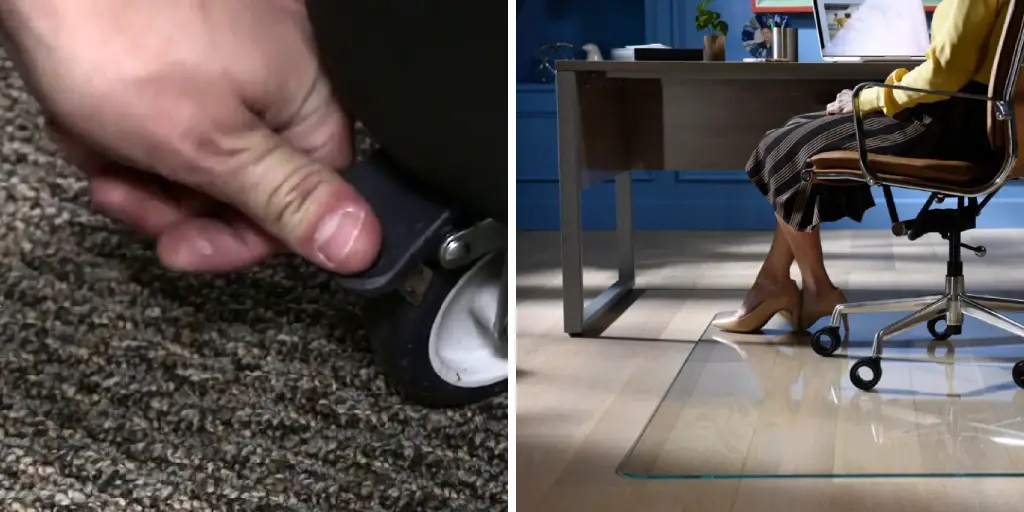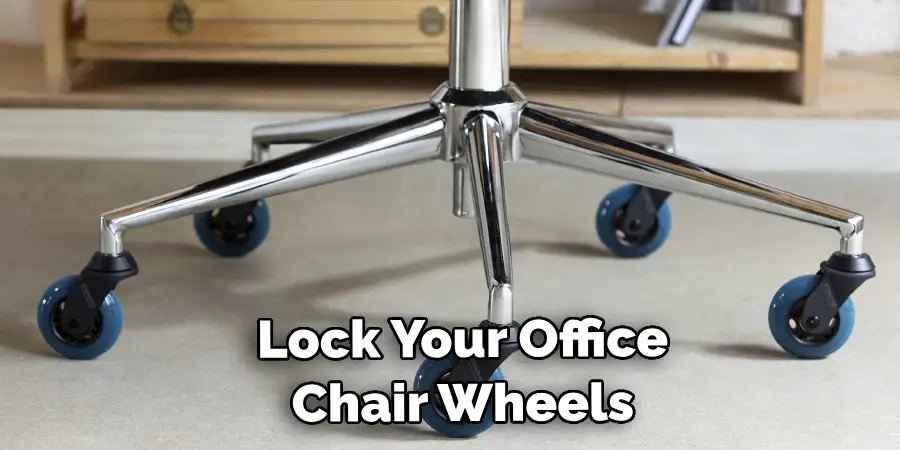Are you tired of your office chair rolling around whenever you stand up? Do you find yourself chasing it across the room, or constantly having to readjust its position? You might think that your only option is to buy a new chair with locking wheels, but that doesn’t have to be the case. With this guide, you’ll learn how to lock office chair wheels quickly and easily without spending tons of money on an upgrade!

Why Should You Lock Your Office Chair Wheels?
Before we dive into the methods of locking office chair wheels, let’s first discuss why you should bother at all. Locked wheels prevent your chair from accidentally rolling away and causing accidents while you’re out of your seat. This is especially important if you tend to leave your chair on an incline or near edges where it could easily roll off.
Additionally, locking your chair can also help improve your posture and reduce strain on your back, as you won’t have to constantly readjust the position of your chair while sitting. Overall, locking your office chair wheels may seem like a small task, but it can greatly improve both safety and comfort in the workplace.
9 Best Methods on How to Lock Office Chair Wheels
1. Brakes or Locking Mechanisms:
Some office chairs come with built-in brakes or locking mechanisms that allow you to lock the wheels in place. These can typically be activated by pressing a lever or flipping a switch located near the base of the chair. If your chair has this feature, simply engage it whenever you want to keep your chair stationary. This is the most convenient and reliable method for locking office chair wheels, but not all chairs come with this feature.
2. Using Rubber Bands:
If your chair doesn’t have a built-in braking system, you can use rubber bands to lock the wheels in place. Simply wrap two or three rubber bands tightly around each wheel until they are snug against the base of the chair. This will create enough friction to prevent the wheels from rolling, but be sure not to wrap them too tightly or they may damage the wheels. This method is a quick and cheap solution, but it may not be as effective as other methods.

3. Placing Objects in Front of the Wheels:
Another simple method for locking office chair wheels is to place an object in front of them to prevent them from rolling. This can be anything from a heavy book or box to a small trash can or recycling bin. Just make sure the object is heavy enough and placed close enough to the wheels to keep them from moving. This method may not be as secure as others, but it can work in a pinch.
4. Using Duct Tape:
For a more permanent solution, you can use duct tape to lock your office chair wheels. Simply wrap several layers of duct tape around the base of each wheel, making sure to cover the entire circumference. This will create enough friction to keep the wheels in place, but it may leave a sticky residue on your floors over time.
5. Installing Caster Stops:
Caster stops are small plastic or rubber pieces that can be attached to the base of your office chair’s wheels to prevent them from rolling. They are easy to install and can be found at most office supply stores. Simply place them on the bottom of each wheel and they will act as a brake, keeping your chair in place when needed.
6. Using Threaded Inserts:
Threaded inserts are small metal pieces that can be screwed into the base of your office chair’s wheels to create a locking mechanism. You can find them at most hardware stores and they come with instructions for installation. Once in place, you can use a small wrench or pliers to tighten the inserts, creating enough friction to keep the wheels from rolling.
7. Applying Rubber Adhesive Pads:

Similar to using rubber bands, you can also apply adhesive rubber pads directly onto the wheels to prevent them from rolling. These can be found at most hardware or office supply stores and are easy to apply by simply peeling off the backing and pressing them onto the wheels. This method may not be as secure as others, but it is a quick and simple solution.
8. Using Furniture Grippers:
Furniture grippers are small rubber or plastic pieces that can be placed under the base of your office chair’s wheels to keep them from moving. They are designed to prevent furniture from sliding on hard surfaces, so they work well for locking office chair wheels as well. Simply place one under each wheel and it will act as a brake, keeping your chair in place.
9. Switching Out Wheels:
If you’re feeling handy, you can also replace your office chair’s wheels with locking casters. These are specially designed wheels that have a locking mechanism built-in, allowing you to easily lock them in place when needed. To switch out the wheels, simply remove the old ones and replace them with the locking casters using a screwdriver or pliers. This method may require a bit more effort, but it will provide a long-term solution for locking your office chair wheels.
Following these methods, you can easily and effectively lock your office chair wheels without having to spend a ton of money on a new chair. Just remember to always engage the locking mechanism or use one of the other methods whenever you get up from your seat to prevent any accidents or discomfort.
With locked wheels, you can focus on your work without constantly worrying about your chair rolling away! So, choose the method that works best for you and enjoy a safer and more comfortable work environment. Happy wheel-locking!
Additional Tips and Tricks to Lock Office Chair Wheels
1. If you have a hard time keeping your office chair in place and preventing it from rolling around, consider investing in a plastic mat or rug to place under the wheels. This will add traction and prevent the wheels from moving too freely.

2. If you have hardwood or tile floors, try placing rubber caster cups under each wheel of your office chair. These small cups provide extra grip and can help keep your chair in place.
3. If you want a more permanent solution, consider replacing the casters on your office chair with locking ones. These casters have a mechanism that allows you to lock them in place, preventing any unwanted movement.
4. Another option is to use adhesive strips or rubber pads on the bottom of each wheel. This will add extra grip and prevent your chair from sliding around.
5. If you have a swivel office chair, make sure to tighten the base screw regularly. Over time, the screw may loosen and cause the chair to wobble or move more easily.
6. Regularly clean and maintain your office chair wheels. Dust, dirt, and debris can build up on the wheels and affect their performance. Use a damp cloth to wipe down the wheels and remove any buildup.
7. Consider the weight capacity of your office chair when purchasing one. A chair with a higher weight capacity will typically have stronger, more durable wheels that are less likely to move around.
8. If you often find yourself leaning or rocking in your office chair, try using a footrest. This will help distribute your weight more evenly and prevent the chair from moving too much.
9. Check the locking mechanism on your office chair regularly to make sure it is functioning properly. If you notice any issues, have it repaired or replaced immediately.
10. Finally, always remember to lock your office chair wheels when not in use. This will prevent any accidents or injuries caused by the chair rolling away unexpectedly.

Following these tips and tricks will help you keep your office chair in place and prevent any unwanted movement. Don’t let constantly rolling chairs be a distraction in your workspace – take control and lock those wheels! So, make sure to use the methods mentioned above to secure your office chair and have a productive day at work. Happy locking!
Frequently Asked Questions
What Are the Benefits of Locking Office Chair Wheels?
Locking office chair wheels can provide several benefits, including increased stability and safety while working, better posture and ergonomics, and improved productivity. By preventing the chair from rolling around, you can focus on your work without worrying about unnecessary movements or potential accidents.
Is It Safe to Lock My Office Chair Wheels?
Yes, it is safe to lock your office chair wheels as long as you follow proper instructions and use a high-quality chair. Most chairs are designed with locking capabilities in mind and can withstand regular use of the lock feature without damaging any parts or compromising safety. However, it is important to use caution when unlocking the wheels and make sure to release them gently to avoid any sudden movements or accidents.
Can I Still Move My Chair When the Wheels are Locked?
In most cases, yes, you can still move your chair while the wheels are locked. Some chairs even have a feature that allows you to adjust the level of resistance when moving the chair with locked wheels. However, it is important to note that the range of motion may be limited and you should not try to forcefully move or tilt your chair while the wheels are locked, as it may damage the locking mechanism or cause instability.
How Often Should I Lock My Office Chair Wheels?

There is no set rule for how often you should lock your office chair wheels, as it largely depends on your personal preference and work habits. However, it is recommended to lock the wheels when you are sitting in a fixed position for extended periods, such as during intense focus or meetings. It is also a good idea to lock the wheels before standing up from your chair to avoid any unexpected movements or accidents.
Conclusion
Now you know how to lock office chair wheels and the benefits that come with it. Remember to use caution when unlocking the wheels and always make sure to release them gently. By incorporating this simple habit into your work routine, you can improve your posture, safety, and productivity while sitting in your office chair. So why wait? Give it a try and see the difference for yourself! The result will be a more comfortable and enjoyable work experience. Happy locking!
